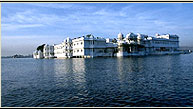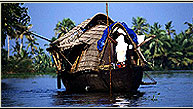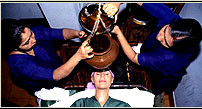-| Indian Geography | -

India,
it is often said, is not a country but a continent. From north to south and
east to west, the people are different, custom and traditions are different.
Area
India has a total area of 3,287,263 sq.km. This is divided in to 26 states and
6 directly administered union territories.
Himalayan
The north of the country is decisively bordered by the long sweep of the
Himalaya, highest mountains of earth. They run from southest of northwest, separating
India from China, Bhutan in and Nepal. The Himalaya is the one of youngest mountain
ranges in the world. Its evolution can be traced to the jurassic era (80 million
yers ago). The Himalays are not a single mountain range but series of ranges
with beautiful valley in different places in India. Kanchenjunga (8598 m) is
the highest mountain in India.
The northern Plain
In the complete contrast to the soaring mountain peaks, the northern plainn
is opressively flat and slopes so gradually that all the way from delhi to Bay
of Bengal it drops only 200m. The mighty Gangs river, which has its source in
the Himalayas, drains a large part of the northern plain and is the major river
in India.
The North-East
The foothills of the Himalayas, which separate the country from myammar
(Burma), define the northestern boundary of India. In this region, India bends
almost entirely around Bangladesh and almost meets the sea on the estern side.
Centre & South
South of the northern plains, the land rises up into the high plateau of
the Deccan. The plateau is bordered on the both sides by ranges of the hills,
which parallel the coast to the east and the west.
The West
On the

western side, three distinct region separtae India from Pakistan. In north India
in the disputed area of Kashmir, the Himalayas froms the boundary between the
two centuries. The Himalayas drop down to the plain of Punjab, which then merge
into the Great Thar Desert in the western part of the Rajasthan. This is an
aea of great natural beauty and extreme barrennes.
It's hard to imagine that it was one covered by thic forests.Discoveries made
that the area was inhabtied by dinosaurs and thier ancestors as far back as
300 million years ago. India is the one of few countries in the world today
in whch the social and religious structures which define the nation's identity
remain intact, and have continued to do so for at least 5000 years despite invasions,
famines, religious,persecutons, political upheavals.
There are many country which would qualify for such a description in terms of
the different ethnic groups, languages, religions, geography and traditions
which make up the whole, but few can match the diversity to be found in India.
The modern state it self is a relatively recent creation bourn out of a people's
desire to throw off the yoke of colonialism.
Basically India is what you make of it and what you want it to be. If you want
to see temples with enough styles and types to confuse anybody. If it's a history
you wnt India has plenty of it; the forts battelfields, ruins and monuments
all have their own histories.
If you simply want to lay your back on the beach there are an enough of those
to satisfy the most avid sun worshipper.
Indian Geography in India
Reservation Form




 India,
it is often said, is not a country but a continent. From north to south and
east to west, the people are different, custom and traditions are different.
India,
it is often said, is not a country but a continent. From north to south and
east to west, the people are different, custom and traditions are different.
 western side, three distinct region separtae India from Pakistan. In north India
in the disputed area of Kashmir, the Himalayas froms the boundary between the
two centuries. The Himalayas drop down to the plain of Punjab, which then merge
into the Great Thar Desert in the western part of the Rajasthan. This is an
aea of great natural beauty and extreme barrennes.
western side, three distinct region separtae India from Pakistan. In north India
in the disputed area of Kashmir, the Himalayas froms the boundary between the
two centuries. The Himalayas drop down to the plain of Punjab, which then merge
into the Great Thar Desert in the western part of the Rajasthan. This is an
aea of great natural beauty and extreme barrennes.